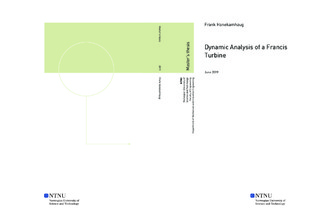| dc.contributor.advisor | Haugen, Bjørn | |
| dc.contributor.author | Hanekamhaug, Frank | |
| dc.date.accessioned | 2019-10-18T14:05:53Z | |
| dc.date.available | 2019-10-18T14:05:53Z | |
| dc.date.issued | 2019 | |
| dc.identifier.uri | http://hdl.handle.net/11250/2623230 | |
| dc.description.abstract | Francisturbiner er velkjente installasjoner i norske vannkraftverk.
De dynamiske egenskapene til en Francisturbin påvirkes signifikant av miljøet den opererer i, det er derfor et stort ønske å forstå samspillet mellom turbin og vann bedre for å sikre stabil kraftproduksjon.
Denne masteroppgaven betrakter en forenklet modell av en Francisturbin, modellen er nedsenket i vann og blir utsatt for en støtkraft.
Det ble utført to forskjellige analysemetoder på modellen, begge utført i Abaqus explicit dynamics. En akustisk-struktur koblet analyse og en Euler-Lagrange koblet analyse.
Det er lagt vekt på oppsett og resultater fra simuleringene for å finne den best egnede metoden for denne type problemer.
Metodene er svært ulike, og det er derfor utfordrende å tilegne identiske forutsetninger i simuleringene.
Den akustisk-struktur koblede analysen viste seg som en svært pålitelig metode. Tolkning av energimengdene indikerte en optimal simulering.
Et dempingsforhold ble utregnet fra forskyvningens amplituder, og grunnet fravær av viskositet i de akustiske elementene ble dempingforholdet lavt.
Den Euler-Lagrange koblete analysen var tvetydig i henhold til pålitelighet. Energimengdene tilstede i simuleringen indikerte en ikke-optimalisert simulering, og nødvendige tiltak er derfor anbefalt.
Dempingsforholdet ble utregnet fra forskyvningens amplituder, og det ble funnet et høyere dempingsforhold enn for den akustisk-struktur koblede analysen.
Euler-Lagrange metoden ble ansett best egent, selv med indikasjonene på en ikke-optimalisert simulering.
Metoden viser seg å være allsidig og har mulighet for å implementeres i mer avanserte problemer. | |
| dc.description.abstract | Francis turbines are frequently used in Norwegian hydropower plants.
The dynamic properties of a Francis turbine are significantly affected by the environment in which it operates, so it is a great desire to better understand the interaction between turbine and water to ensure stable power production.
This master thesis considers a simplified model of a Francis turbine, the model is immersed in water and is subjected to an instantaneous force.
Two different analysis methods were performed on the model, both performed in Abaqus explicit dynamics. An acoustic-structure coupled analysis and a Euler-Lagrange coupled analysis.
Emphasis has been placed on the setup and results of the simulations to find the most suitable method for this type of problem.
The methods are very different, and it is therefore challenging to assign identical assumptions in the simulations.
The acoustic-structure coupled analysis proved to be a highly reliable method. Interpreting the amount of energy indicated an optimal simulation.
A damping ratio was calculated from the displacement amplitudes, and due to the absence of viscosity in the acoustic elements, the damping ratio was low.
The Euler-Lagrange coupled analysis was ambiguous according to reliability. The amounts of energy present in the simulation indicated a non-optimized simulation, and the necessary measures are therefore recommended.
The damping ratio was calculated from the displacement amplitudes, and a higher damping ratio was calculated than the acoustic-structure coupled analysis.
The Euler-Lagrange method was considered most appropriate, even with the indications of an unoptimized simulation.
The method turns out to be versatile and has the ability to be implemented in more advanced problems. | |
| dc.language | eng | |
| dc.publisher | NTNU | |
| dc.title | Dynamic Analysis of a Francis Turbine | |
| dc.type | Master thesis | |
